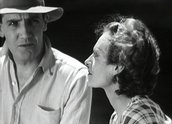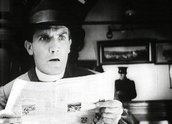


The Silence of Dean Maitland (1934)
Synopsis
A young clergyman, Cyril Maitland (John Longden) falls in love with a beautiful young vamp, Alma Lee (Charlotte Francis), in a seaside town. He is engaged to another woman, but Alma becomes pregnant. When her father Ben (Les Warton) finds out, he attacks the pastor and is killed in a fall. Maitland’s closest friend, Doctor Henry Everard (John Warwick) gets the blame, but neither Alma nor Maitland speaks up to clear him. Everard spends 20 years in jail as Maitland becomes a well-known author and bishop. On his release from jail, Everard comes to kill the man who ruined his life.
Curator’s notes
Ken G Hall wrote in his memoirs that he was initially reluctant to make this film, which was suggested by the boss of Union Theatres, Stuart Doyle. The original novel had been turned into a successful stage melodrama well before Raymond Longford filmed it in 1913. Hall found both book and play unfilmable, in the context of the sound era, but he persevered and the film became one of his biggest successes.
The scandalous story was updated, the dialogue modernised, and Hall pushed the bounds of how much of the sex could be shown, rather than suggested. The censors reacted on cue, objecting to Charlotte Francis’s brief seaside nude scene at the beginning, and demanding a trim to the only scene in which the pastor actually kisses her. The Cinesound publicity department fed the controversy in the newspapers and supplied photos to keep it going.
To modern eyes, the film retains much of its melodramatic origins, but Hall tried his best to minimise these old-fashioned techniques. He was very concerned that the production would incite religious anger, but it was a popular smash instead.
The original novel was set in England, and Hall made it look and sound like it was filmed there – which may have deflected some religious ire from the local churches. Much of it was filmed around Camden, NSW where Hall’s mother came from.
The cinematographer was Frank Hurley, making his second film for Cinesound Productions. Hurley’s command of studio lighting is evident in the studio-bound scenes. He continued as Cinesound’s chief cameraman for the next four years, shooting all or part of Hall’s successive features.
The version of Maitland released in England was cut down, but was still successful. That version was about 13 minutes shorter than the original running time of 95 minutes. Both versions are preserved in the National Film and Sound Archive.
- Overview
- Curator’s notes
- Video 3 clips
- Principal credits
- Find a copy
- Make a comment
- Map
- Add your review



